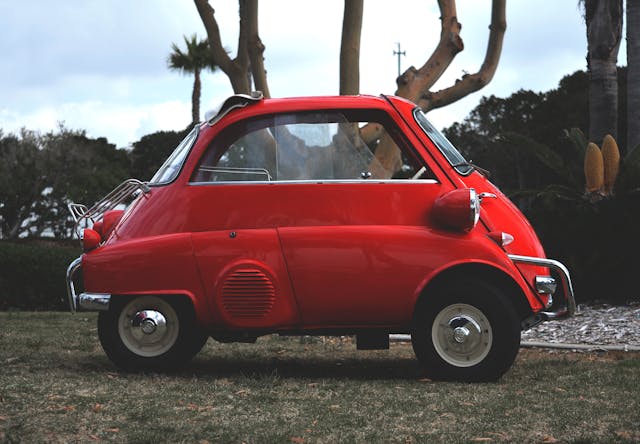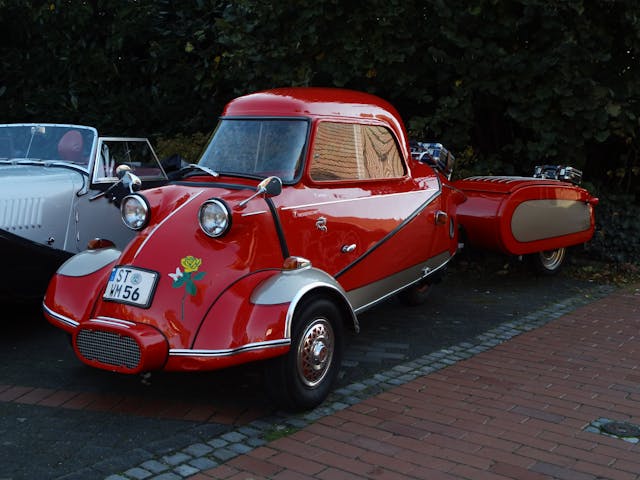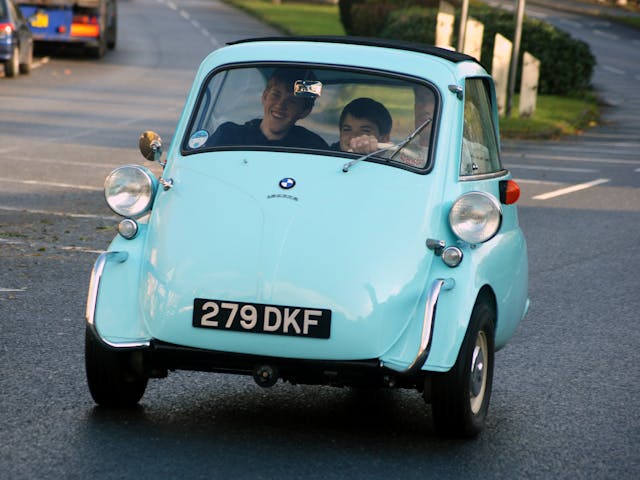Media | Articles
With microcars on the rise, weird and wacky is the name of the game

“Bubble cars” is the name given to those diminutive transportation devices that emerged from the ruins of postwar Germany. Companies such as BMW and Messerschmitt were forbidden from manufacturing airplanes and aero engines, so they turned to building miniature cars that were basically enclosed scooters. The name for them in German, in fact, is Kabinenroller, which translates as “cabin roller,” or enclosed scooter. Powered by one- or two-cylinder air-cooled engines with less than 500 cubic centimeters of displacement and riding on three or four wheels, Kabinenroller helped put the country back on wheels while providing much-needed jobs.
“BMW, which had been building aircraft engines, used its single-cylinder motorcycle engines to power the Italian-designed Isetta,” explains Burt Richmond, long-time collector and vice president of the recently formed MicroMini Car Club. “Another German airplane manufacturer, Heinkel, took its scooter engine and developed its own bubble car, similar to the Isetta, with a front-opening door.” Aircraft-design elements such as Plexiglas domes and side windows also found their way into the microcars, notes Richmond, while Messerschmitt used a tubular fuselage, tandem seating, steering yoke, and top-opening bubble canopy.

Today, bubble cars—also known as microcars—are a fun way to get into the collector-car hobby. They are easy to repair, economical to drive, and are relatively affordable. The market for these little scamps has cooled following its high back in 2013, when a collection of 200 microcars owned by Bruce Weiner was auctioned off with total sales of $8,093,850 and an average per-vehicle price of $40,469. The high point of the auction was a 1958 F.M.R. TG500 “Tiger,” (a high-performance Messerschmitt variant by F.M.R.), which sold at $322,000—double its market value of $150,000.
Has the bubble-car bubble burst? Only for a few models. Though some are appreciating faster than others, values for these pint-sized vehicles are on the rise. Using insurance quotes as a sign of buying intent, we looked at the changes in the demographics of potential buyers who were interested in these microcars to see whether they helped explain changes in value. Here’s what we found.
The microcar trend is moving away from well-known (and expensive) staples such as the BMW Isetta. Values for average #2 (Excellent) condition Isettas have dropped by 21 percent since January 2018, going from $42,500 to $33,800. Although the number of quotes have increased by 20 percent each year, the Isetta is having a hard time capturing the interest of young buyers. The percentage of quotes from boomers increased by five points since 2018 (from 56 to 61 percent). During the same time, millennial interest dropped from 11 to just 3 percent. For values to stay high, the pool of buyers needs to be continually refreshed; that’s impossible if younger buyers don’t show any interest.
Marketplace
Buy and sell classics with confidence

Microcars for the masses—such as the Fiat 500, the classic Mini, and the Citroën 2CV—have remained steady for the last few years. Average #2 values for the 500 are up by only 2 percent since January 2018, from $24,300 to $24,850. Contrary to the BMW Isetta, the Fiat 500 appeals to virtually every age group, which has helped it maintain value. The proportion of interest (determined using insurance quotes) from each generation has remained steady the past few years, with a healthy 36 and 25 percent of quotes coming from Gen Xers and millennials, respectively, in 2020. Boomers accounted for 35 percent of quotes, and pre-boomers for the remaining 4.
Like the Fiat 500, the classic Mini possesses broad appeal across generations, and its #2-condition values are also nudging upward, from $29,550 in January of 2018 to $31,200. The Mini’s popularity among millennials and Gen Xers has likely helped to buoy its values: In 2020, millennials accounted for 30 percent of quotes, and Gen Xers for 37.

Citroën’s delightfully weird 2CV attracts the attention of a slightly older market, but values are also on the rise. A #2-condition 2CV in January 2018 was worth $22,750; now, that figure sits at $25,050. Though interest skews older for the 2CV—boomers submit 57 percent of quotes—values may have increased solely because it’s among the more affordable models in the microcar kingdom.

The market appears to be moving towards oddball yacht cars such as the Fiat Jolly and the Mini Moke. This group of cars is disproportionately collected by Boomers, who account for 51 percent of Fiat Jolly quotes and 64 percent of Mini Moke quotes. While average #2-condition values for more pedestrian microcars increased by single digits in the past three years, the Jolly and the Moke have seen 30 and 40 percent increases. Fiat built both a 500 and a more powerful 600 Jolly model; values for the 500 Jolly jumped from $58,400 in January of 2018 to $64,700 three years later. That’s an 11 percent increase—respectable, until compared with the 42 percent uptick in 600 Jolly values in the same time period. An average #2-condition 600 Jolly is now worth a whopping $84,600.

The Mini Moke, while just as eclectic, is far more affordable, though values are also on the double-digit rise. Since January 2018, values for #2-condition Mokes leaped from $25,700 to $33,500, a 30 percent increase.

The previously overlooked Subaru 360 is having a moment, likely because it was so undervalued for so long. The 360 may benefit from the recent craze surrounding Japanese classics, too. Subaru 360 values quadrupled in the last edition of the Hagerty Price Guide: Average value for #2-condition car sat at $9400 in January of 2018. Two years later, that figure rested at $43,100. Many generations are showing interest in the Subaru 360; in 2020, Boomers submitted 50 percent of quotes, while Gen X and Millennials accounted for 22 percent and 28 percent, respectively.

If you’re looking to buy a collector car that stands out from the herd of garden-variety muscle cars, bubble cars are hard to beat; driving one is like being in a parade wherever you go. “Purely in terms of maximum enjoyment for the smallest investment, nothing gets more attention and ‘smiles per mile’ than a microcar,” sums up Richmond. “To the chagrin of the exotic- and muscle-car crowds, those damn microcars always steal the show.”
Like this article? Check out Hagerty Insider, our website devoted to tracking trends in the collector vehicle market.

























